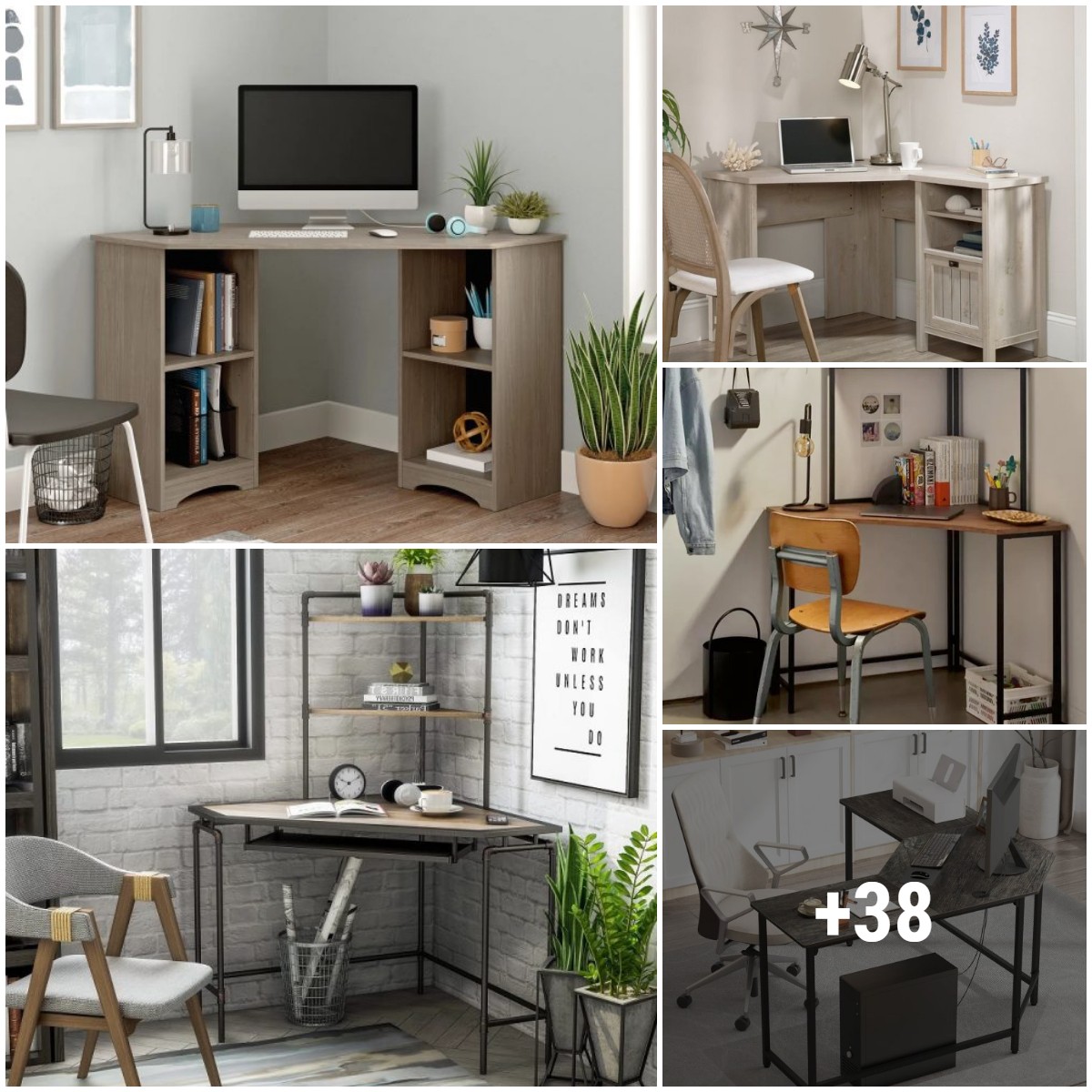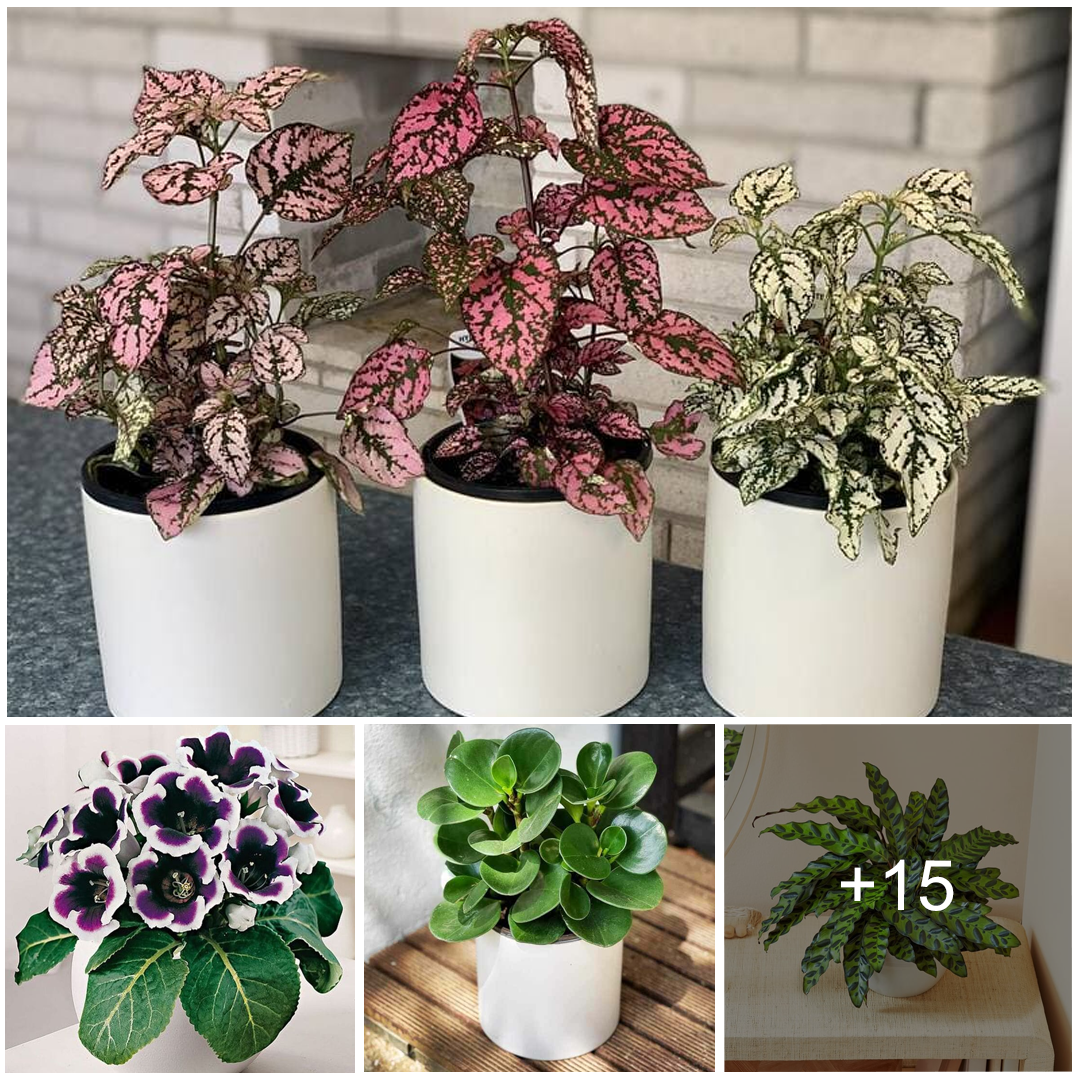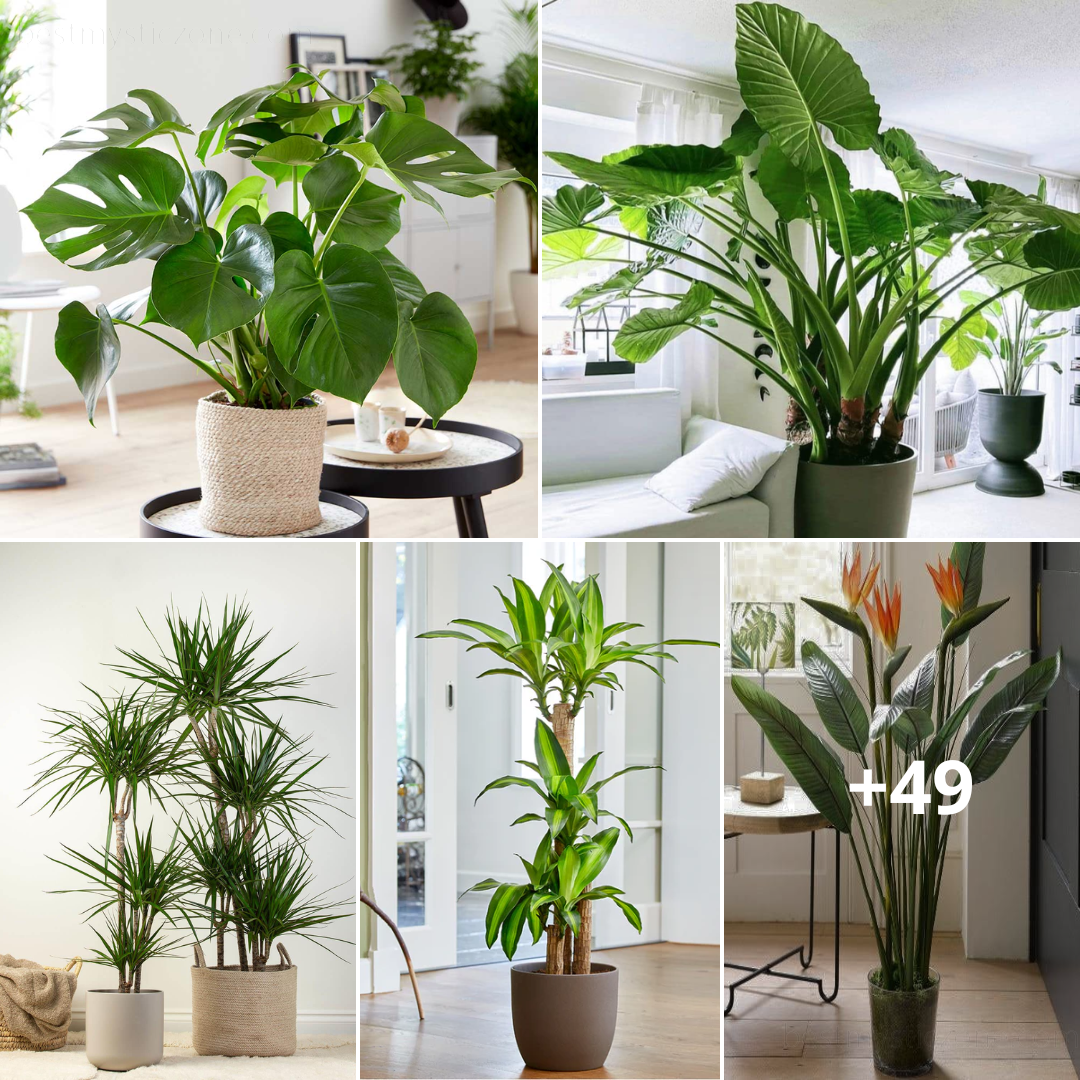Houseplants That Remove Formaldehyde
1. Boston Fern
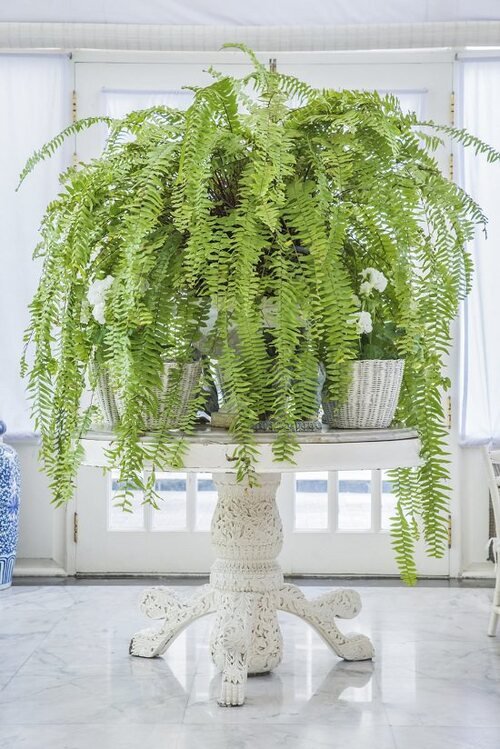
The graceful Boston fern is a close relative of sword fern and tops the list of the best plants to remove formaldehyde. However, the leaves are smaller and compact. Apart from formaldehyde, Boston fern also removes toluene and xylene from the surrounding air, according to NASA clean air study.
Growing requirements: Indirect sunlight, moderate temperatures, humidity, constantly moist, humus-rich potting soil.
Special Features
- Ranks highest among all plants for its ability to filter out formaldehyde from the air soaks up odors as well.
- Grows well in containers, in a hanging basket, and indoors.
Container Varieties
- Dallas: Rapid grower with small fronds that are easier to maintain
- Fluffy Duffy: Fine-textured plant
- Massii: Darker green in color and more dense growth habitat
Tips for Care
- Water frequently.
- Provide liquid feed twice a month in the growing period.
- Keep these ferns in indirect sunlight; a few hours of morning sunlight is optimum.
- Prune when the plant gets unruly or starts spilling from the pot.
Pairs Well with
- Croton
- Geranium
- Lantana
- Plumbago
2. Peace Lily
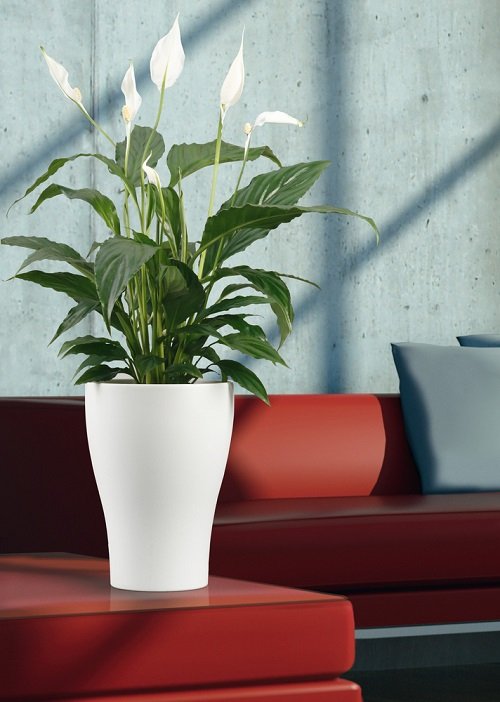
The air-purifying properties of peace lily coupled with their striking white bracts and dark green foliage make them great plants for formaldehyde. It can remove formaldehyde effectively. Check out this study for validation!
Growing Requirements: Indirect sunlight, high humidity, well-draining soil, and slight moisture.
Special Features
- Hardy and easy to grow indoors.
- Filters out toxins like ammonia, benzene, formaldehyde, xylene.
- Has a high transpiration rate and humidifies indoor air.
Container Varieties
- Power Petite: Around 15-inches tall
- Wallisii: 15-inches tall with rippled leaves
- Mauna Loa Supreme: Reaches 3 feet with glossy leaves
- Clevelandii: Reaches 1-3 feet with unusually large leaves
- Flower Power: Rapid bloomer
- Domino: Variegated peace lily
- Little Angel Peace Lily: Long-lasting blooms, dwarf variety
Tips for Care
- Water thoroughly but allow sufficient time to dry out a bit between watering spells.
- Mist the leaves frequently to repel pests.
- Grow in high light situations for prolific blooms.
- Fertilize twice a year with NPK-rich fertilizer.
Pairs Well with
- Elephant Ears
- Zebra plant
- Caladium
3. Kimberley Queen Fern
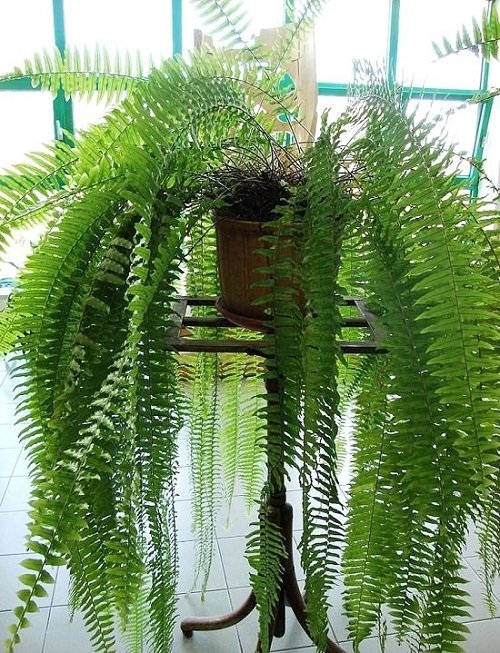
The Kimberley Queen Fern has feathery upright green fronds and ranks just as high in removing formaldehyde and xylene. However, it is more versatile and amenable to container culture. Also, check out our informative article on ferns you can grow in pots.
Growing Requirements: Partial shade, filtered light, evenly moist soil, warm surrounding.
Special Features
- Pet-friendly.
- Stays upright, like the Boston Fern, and it is easier to prune and grow.
- Tolerant of indoor humidity.
Tips for Care
- It prefers a slightly moist growing medium, but let the soil dry out well before watering when growing indoors.
- Fertilize once a month.
- Keep removing dead fronds throughout the year and prune the plant if required at the beginning of the growing season.
Pairs Well with
- Sculpted boxwoods
- Tall grasses
- Shade-lovers like New Guinea Impatiens
- Ivy
4. Dracaena
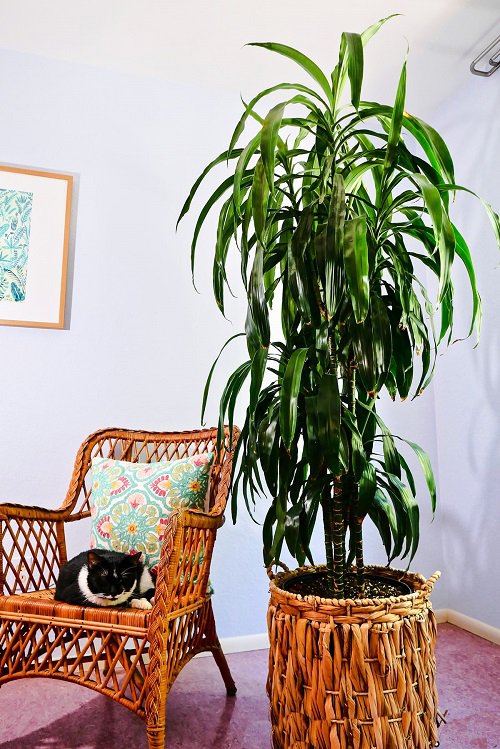
Looking for the best plants to remove formaldehyde? A subtropical plant, dracaena sports beautiful variegated foliage borne on stout stalks, making it easy to grow in containers.
Growing requirements: Brightly filtered sunlight, medium watering, optimum soil drainage, weekly fertilizing.
Special Features
- Low maintenance plant.
- Removes formaldehyde and other VOCs like xylene and trichloroethylene from indoor air.
- Proven in the clean air study.
- Improves indoor humidity.
Container Varieties
- Janet Craig: Smaller variety with dark green foliage
- Malaika: Striking variegations
- Lemon Surprise: Twisted leaves and a bushy form; perfect for desktop decor
Tips for Care
- Water once a week or when the topsoil goes dry.
- Fertilize every six months or thrice a year for more growth.
- Try increasing humidity when you observe the browning of leaf tips.
- Prune off the top if it gets scraggly and overly tall.
- Place dracaena in bright light for rapid growth.
Pairs Well with
- Asparagus Fern
- Devil’s Ivy
- Ferns
5. English Ivy
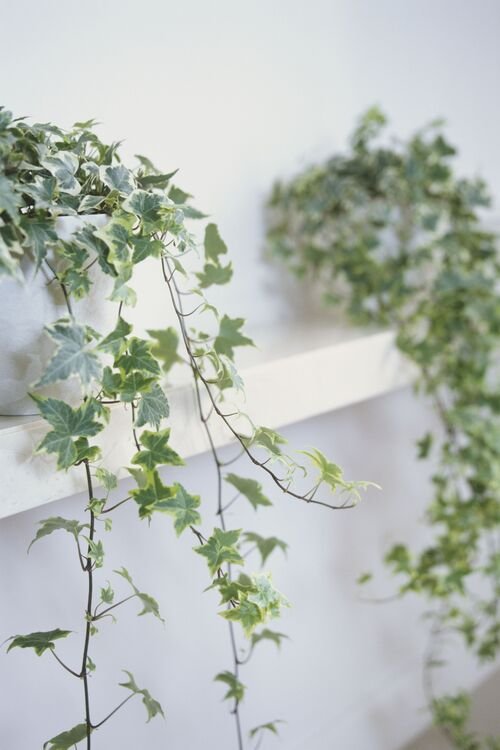
One of the best indoor vines and plants for formaldehyde, we also added it to our list; check it out here. Ivy can remove the formaldehyde and other volatile organic compounds (VOC) aptly, and growing it is easy well.
Growing requirements: Indirect sunlight, quality potting soil, protection from drafts, and heat vents.
Special Features
- Effective against toluene, benzene, and formaldehyde.
- It helps reduce mold formation on walls, check out this article.
- Resistant to deer and rabbits.
Container Varieties
- Jubilee: Dwarf variety with silver-lining on leaves
- Spectre: Clinging runner perfect for deck railings
- Calico: Tiny white leaves and a clumping habitat
Tips for Care
- Water deeply but allow the soil to dry out between watering spells.
- Air circulation is a must.
- Refrain from fertilizing when the plant stops growing.
Pairs Well with
- Holly
- Geranium
- Angelonia
- Snake Plant
6. Weeping Fig
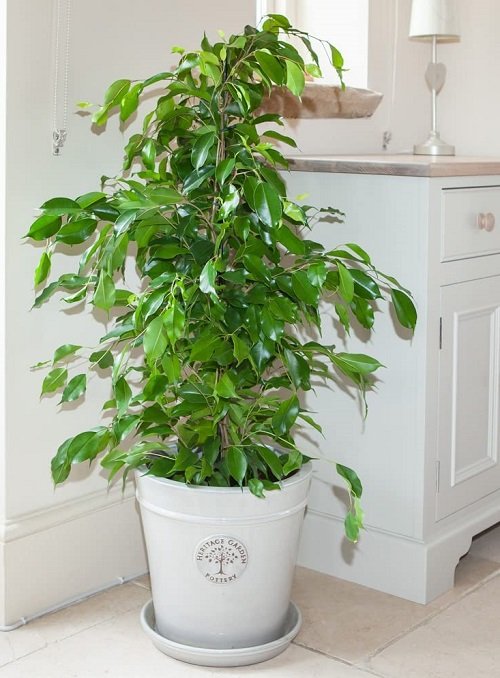
Its droopy, emerald-green leaves contrast beautifully with its tan trunk, while its toxin-absorbing quality makes it a winner among plants that filter formaldehyde.
Growing requirements: Bright, filtered sunlight, yearly pruning, regular watering.
Special Features
- Cleanses out airborne impurities commonly emitted from carpeting and furniture, such as benzene, carbon monoxide, and formaldehyde.
- Long-lasting.
- Forgiving of temperature fluctuations.
Container Varieties
- Bushy King: Compact, bushy form
- Danielle: Sturdy, resistant to leaf drop
- Judith: Small-leaf variety overwinters easily
- Wasana: Bonsai plant
Tips for Care
- Water steadily, but don’t allow the soil to stay wet; else, plants will suffer from root rot.
- Feed heavily, twice in the growing season.
- Plant in bright light for rapid growth.
- Fast-draining potting soil works best.
Pairs Well with
- Palms
- Schefflera
- Dieffenbachia
- Spider plant
7. Lady Palm
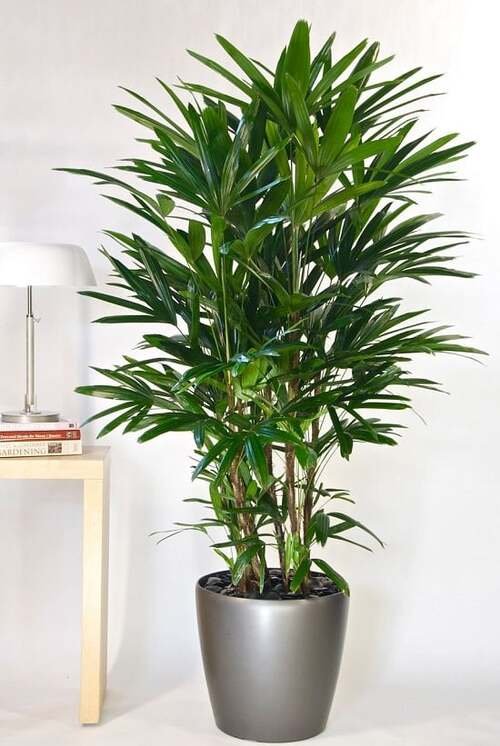
Lady palm can grow over 10 feet tall outdoors, but indoors, it doesn’t exceed the reasonable height, and not just the aesthetics; it’s a great air-purifying houseplant. Certainly delivers everything as one of the best plants to remove formaldehyde.
Growing requirements: Partial shade, indirect sunlight, moderate watering.
Special Features
- Tolerant to wide temperature changes.
- Lowers indoor humidity by absorbing moisture through its leaves.
- Freshens air by absorbing airborne pollutants released from furniture, pet fur, and home cleaning products.
Container Varieties
- Japanese Rhapis: Reaches 18-inches tall
Tips for Care
- Water heavily when you observe browning of leaf tips, it can be due to fertilizer overdose and mineral accumulation.
- Use complete fertilizer like 20-20-20 according to the product’s recommended dose to boost growth.
- Water one inch deep in summer but limited water supply in fall and winter.
- Use a well-drained, quality organic potting mix.
Pairs Well with
- Jasmine
- Pentas
- Cordyline
- Heliconia
8. Chrysanthemum
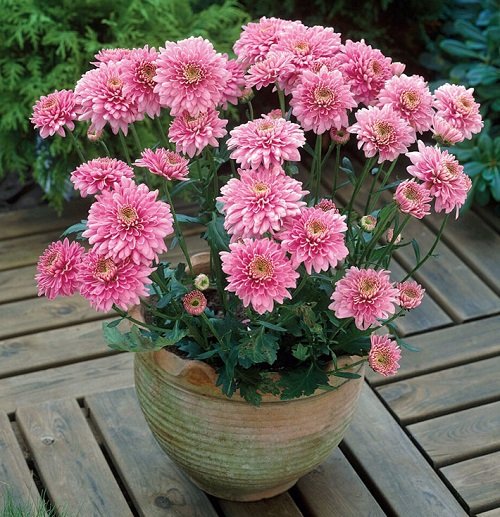
Searching for formaldehyde absorbing plants? This cheery icon of fall is an easy way to add color and freshness to your home. It removes formaldehyde significantly, as proven in the famous NASA study.
Growing Requirements: Full sun, proper air circulation, well-drained soil.
Special Features
- Removes formaldehyde from the air.
- Attractive plant.
- Low maintenance.
Tips for Care
- If possible, keep mums near south or west-facing window or at least provide all day long indirect sunlight.
- Water mums only when one-inch of the topsoil dries out.
- Cut off fading blooms to encourage more flowers.
9. Snake Plant
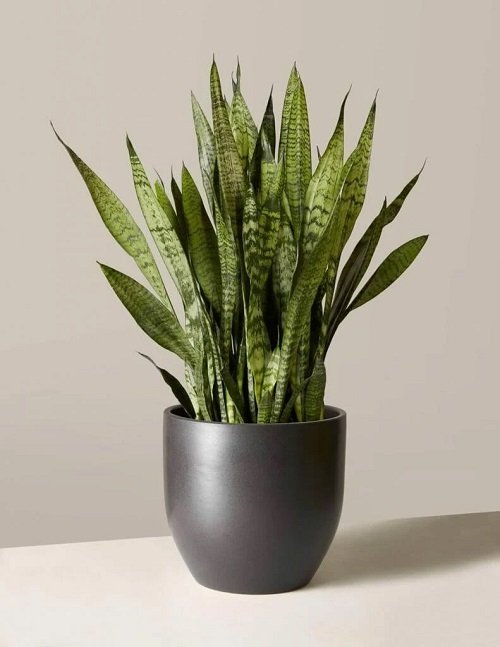
With amazing air-purifying qualities and forgiving nature, the mother-in-law’s tongue is surely one of the best houseplants that remove formaldehyde.
Growing requirements: Direct/indirect sunlight, good air circulation, low watering needs.
Special Features
- Tolerant to neglect; can survive for weeks without water.
- It is known to remove over 100 air pollutants, including chloroform, nitrogen oxide, formaldehyde, and carbon monoxide.
- Removes CO2 at night to freshen up indoor air.
- Check out more snake plant benefits here.
Container Varieties
- Golden Hahnii: Grows 8-inches tall
- Bantel’s Sensation: Grows 3-feet tall
Note: All varieties can grow easily in containers
Tips for Care
- Use a succulent or any regular potting mix with good drainage.
- Feed the plant occasionally during the growing season. The fertilizer requirement is moderate.
- Water carefully, only when the soil is dry.
Pairs Well with
- Sedum
- Aloe
- Ferns
- Trailing succulents
10. Bamboo Palm
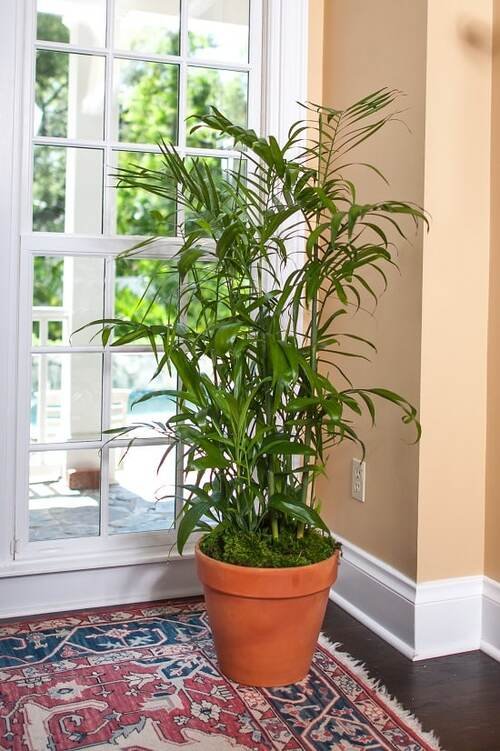
According to this research, indoor air is as polluted as outdoor air in average homes. Large indoor plants like bamboo palm can play a slight role as they are formaldehyde absorbing plants. Plus, a healthy bamboo palm in your room can add also add a tropical touch.
Growing requirements: Bright, filtered sunlight, frequent watering, monthly feeding during the growing season.
Special Features
- Has a penchant for soaking up benzene, carbon monoxide, and formaldehyde from the
- air.
- Humidifies homes, making it suitable for dry climates and people living with breathing issues.
Container Varieties
- Dwarf Bamboo
- Hardy Bamboo
Tips for Care
- Place the plant in a southeast-facing window, the more sunlight it can receive, the better.
- Only water when the soil dries out.
- Rinse regularly with a downstream of water to remove residues and pests.
Pairs Well with
- Snake Plant
- Gerbera
- Parlor Palm
- Fiddle Leaf Fig
11. Chinese Evergreen
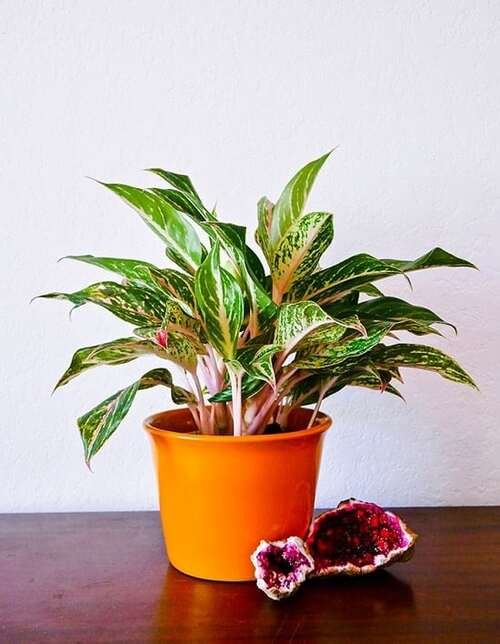
According to this study here, Aglaonema species (Chinese evergreen) is one of the most amazing plants that filter formaldehyde.
Growing requirements: Partial shade or fluorescent lighting, weekly watering, occasional fertilizing, warm to cool temperature.
Special Features
- Low care houseplant.
- Removes formaldehyde and other VOCs.
Container Varieties
- Red Peacock: Colorful, resilient, and easy to maintain
- Cutlass: Dagger-like leaves
- Emerald Bay: Tolerant of low lighting
Tips for Care
- Grow in bright, indirect light. It performs better if it can receive direct morning sunlight.
- Water only when the soil dries out.
- Feed with time-based general-purpose fertilizer twice in the growing season.
Pairs Well with
- Pothos
- ZZ Plant
- Snake Plant
12. Flamingo lily (Anthurium)
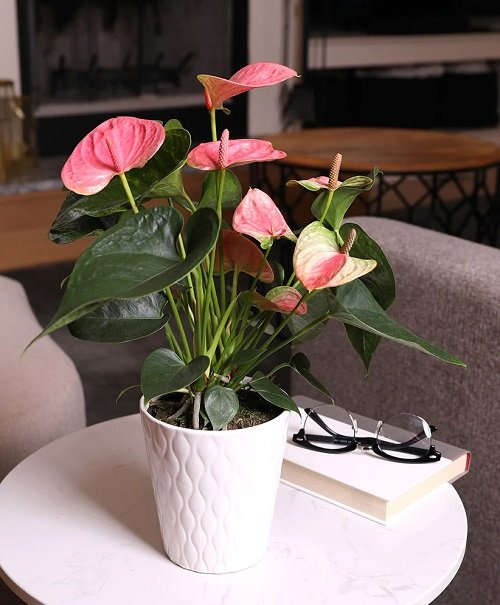
Anthurium is an eye-catching shade perennial with clusters of red spathes. This beautiful plant has heart-shaped leaves and spathes, one more striking feature. If this is not enough, it topped NASA’s air purifying list as well.
Growing requirements: Indirect sunlight, slight moisture, a monthly dose of fertilizer.
Special Features
- Improves indoor air quality by removing xylene and formaldehyde.
- One of the most beautiful houseplants.
- Toxic for human consumption.
Tips for Care
- Their love for high humidity makes them apt for the kitchen or bathroom.
- Fertilizing after every 3-6 months is fine, but they need more fertilizer while blooming.
- In addition to high humidity and warm temperatures, protection from cold drafts is a must.
Pairs Well with
- Red Aglaonema
- Nerve Plant
13. Gerbera Daisy
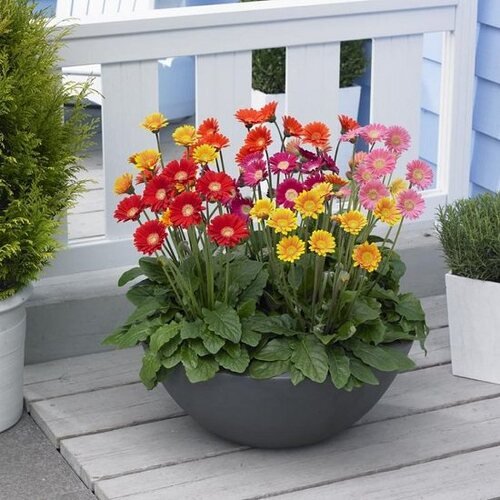
A vivacious plant with beautiful flowers, the Gerbera daisy is a typical florist favorite among formaldehyde removal plants. And the fact that it purifies the indoor air makes it a great houseplant as well.
Growing requirements: Partial shade, medium watering, fertilize once a month in the flowering season.
Special Features
- They are great at removing VOCs and particulate matter, formaldehyde, benzene, and trichloroethylene commonly found in the laundry and dry cleaning.
- Produces beautiful cut flowers.
Tips for Care
- Arrange 3-5 hours of sun exposure daily. The more, the better.
- Water moderately.
- Maintain room temperature warm during active growth and blooming.
- Provide indirect light in winter and water sparingly.
- Use a fertilizer like 15-30-15; the high proportion of phosphorus will help it to flower.
14. Golden Pothos
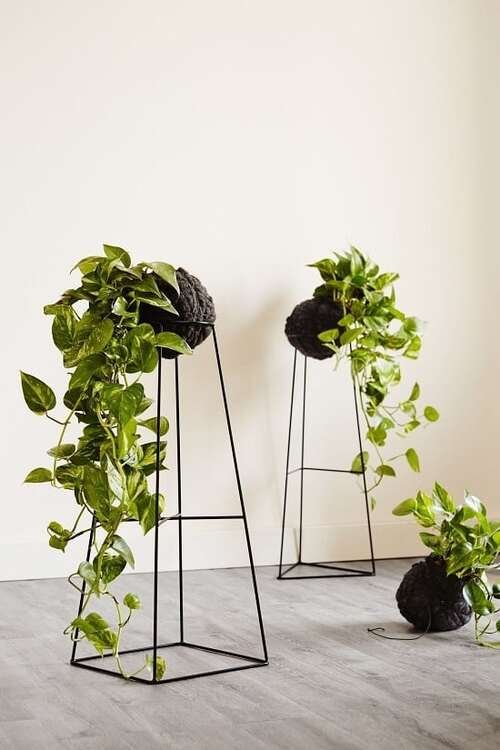
A recent 2016 research supported by NASA by the title “The effect of Golden Pothos in reducing the level of volatile organic compounds in a simulated spacecraft cabin” claims that golden pothos can significantly decrease the VOCs and formaldehyde level from the air. Check it out here!
Growing requirements: Bright, indirect light, well-draining potting soil, bi-monthly feed with a balanced fertilizer
Special Features
- Essentially pest-free.
- Soaks up chemicals like toluene, benzene, xylene, and formaldehyde, proven!
Container Varieties
- Neon: Perfect for dark spaces
- Silver Satin: Tolerant of low-lighting and drought
Tips for Care
- Provide a warm indoor temperature and a sunny location.
- Use well-drained potting soil with acidic pH.
- Feed bi-monthly with a balanced fertilizer.
Pairs Well with
- Dracaena
- Peace Lily
- Palms
15. Spider Plant
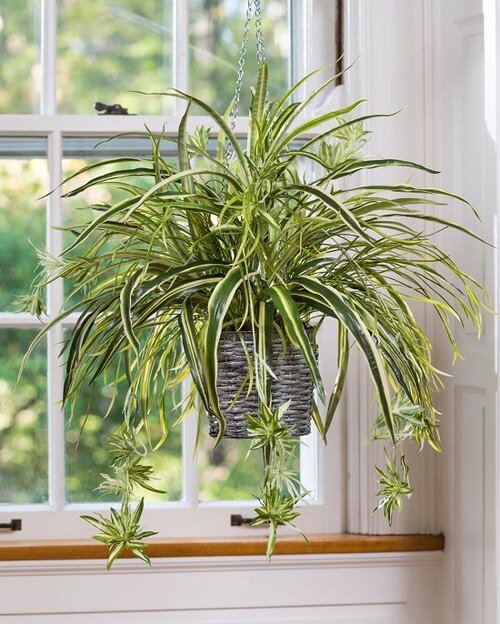
The perfect formaldehyde removal plants for hanging baskets, the low-maintenance spider plant is a champion at odorizing indoor air. Check out this informative article to learn all the spider plant benefits.
Growing requirements: Low lighting, low-to-medium watering, high humidity.
Special Features
- Removes cancer-causing chemicals like formaldehyde from the air, scientifically proven.
- Tolerant of temperature fluctuations and low light.
Tips for Care
- Increase light exposure when the leaves show variegation.
- Increase humidity when the leaf tips turn brown and reduce fertilizing.
- Water once or twice a week.
Pairs Well with
- ZZ plant
- Dracaena
- Houseplant ferns
